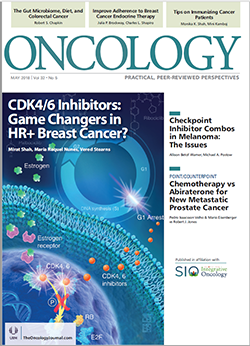POINT: Chemotherapy vs Abiraterone for the Initial Management of Metastatic Prostate Cancer
Chemotherapy is the best option for the initial management of metastatic prostate cancer.
Oncology (Williston Park). 32(5):223-6.

Pedro Isaacsson Velho, MD

Mario A. Eisenberger, MD

The Case for Chemotherapy
The treatment landscape for metastatic prostate cancer has changed considerably with the approval of several life-prolonging systemic therapies. Among the various agents approved since 2004 are traditional chemotherapeutic compounds (docetaxel and cabazitaxel), immunotherapy (sipuleucel-T), a bone-targeted radiopharmaceutical (radium-223), and two novel androgen receptor (AR)-targeted therapies (abiraterone acetate and enzalutamide).[1] Docetaxel, the first chemotherapeutic agent to show a survival advantage in metastatic castration-resistant prostate cancer (CRPC), became the standard nonhormonal treatment in this setting.[2] In addition, two recent placebo-controlled randomized phase III trials reported significantly improved metastasis-free survival in patients with nonmetastatic CRPC: the SPARTAN study,[3] which led to US Food and Drug Administration (FDA) approval of the AR-targeted drug apalutamide, and the PROSPER study,[4] which led to the approval of enzalutamide in this setting.
In 2005, the Eastern Cooperative Oncology Group initiated a trial comparing standard androgen deprivation therapy (ADT) with or without 6 cycles of docetaxel in patients with metastatic hormone-sensitive prostate cancer (HSPC; the CHAARTED study). In a recent updated analysis with a median follow-up time of 53.7 months, the group reported a median overall survival (OS) for the combined treatment arm of 57.6 months compared with 47.2 months for ADT alone (hazard ratio [HR], 0.72; 95% CI, 0.59–0.89; P = .0018).[5] Subgroup analysis indicates that this survival benefit is significant primarily in the group of patients (513 patients) with high-volume disease, defined as presence of visceral metastases and/or 4 or more bone lesions (≥ 1 appendicular lesions) (51.2 months for the combined arm vs 34.4 months for ADT alone; HR, 0.63; 95% CI, 0.50–0.79; P < .001). In the 277 patients classified as having low-volume disease, the OS difference between the two arms was not significant-the median survival in these patients was 58.3 and 59.8 months for the combined and ADT-alone arms, respectively. The combined arm was superior with regard to secondary study endpoints, including time to the development of castration resistance (either by prostate-specific antigen or clinical progression) and time to clinical progression.[5]
The STAMPEDE trial[6] was started in 2005 to test the same chemohormonal hypothesis, and the results reported were similar to those of CHAARTED. The STAMPEDE trial design also addressed the question of whether the addition of zoledronic acid would further improve outcomes, which was eventually shown to not be the case.[6] With a median follow-up of 43 months for 2,962 patients, the latest published report from STAMPEDE showed a significant OS difference in favor of the combined ADT + docetaxel arm (HR, 0.78; 95% CI, 0.66–0.93; P = .006). The median OS was 81 months (range, 30 months to not reached) for the combined arm vs 71 months (range, 32 months to not reached) for the ADT-alone arm. The combination arm also showed significantly improved failure-free survival. Toxicities observed in both CHAARTED and STAMPEDE included those previously reported with docetaxel and were mostly reversible.
A third study (GETUG-AFU 15), involving only 385 patients with mostly (> 50%) low-volume disease as defined in the CHAARTED trial, reported an OS of 58.9 months vs 54.2 months for the combined and ADT-alone arms, which was not significant (median follow-up of 50 months).[7] Toxicities were again similar to those reported in the other two trials.
More recently, two large prospectively randomized phase III studies[8,9] of patients with metastatic HSPC reported significant OS improvements with the addition of abiraterone to standard-of-care ADT. The first (LATITUDE) was a placebo-controlled double-blind study (abiraterone plus prednisone was blinded) that included 1,199 patients randomized to abiraterone + ADT (597 patients) or ADT alone (602 patients). With a median follow-up of 30.4 months, 28% of the patients had died in the abiraterone + ADT arm vs 39% in the ADT-alone arm, which represents a 38% lower risk of death with abiraterone use (HR, 0.62; 95% CI, 0.51–0.76; P < .001).[8]
In the second study (STAMPEDE-abiraterone segment), 1,917 men with metastatic or locally advanced prostate cancer were randomized to receive abiraterone + ADT or ADT alone. The combination arm had a significant improvement in the 3-year survival rate (83% vs 76% in the ADT-alone arm; HR, 0.61; 95% CI, 0.49–0.75).[9] Both studies also reported impressive differences in failure-free and progression-free survival, favoring the abiraterone arms. Toxicity was modest, especially when compared with docetaxel treatment. The survival benefit favoring abiraterone was reported across all extent-of-disease subgroups in these two studies.
The data summarized herein strongly support the notion that the standard treatment for metastatic HSPC should no longer be ADT alone. While previous experience in HSPC patients using combined endocrine manipulations with first-generation antiandrogens and older (less effective) chemotherapy regimens did not result in clinical benefit of the magnitude reported with contemporary systemic approaches, it is clear that the biological heterogeneity of this disease at the time of metastatic presentation remains an important consideration for the design of future trials and underscores the need for additional rationally combined approaches based on biology.
At the present time, the choice between the modalities that can be added to standard ADT remains a major challenge for patients and physicians alike. The results of clinical trials indicate a remarkable similarity in benefits. While it is certainly true that toxicities are more severe with chemotherapy than with abiraterone, they are usually acute and reversible after treatment is discontinued. The median follow-up time in the LATITUDE and STAMPEDE trials was less than 40 months.[8,9] In our opinion, additional follow-up information is necessary to properly evaluate adverse events with longer-term abiraterone plus prednisone use. It is possible that the chronic and incremental testosterone suppression and inhibition of CYP17-lyase and hydroxylase caused by abiraterone and chronic (> 5 years) exposure to 10 mg of prednisone may further increase the incidence and severity of toxicities associated with this type of treatment, such as decreases in bone and muscle mass; fatigue; obesity; a variety of chronic metabolic abnormalities; and, most importantly, the potential risk of progressive cognitive changes currently emphasized as a potential complication of long-term ADT.[10]
Current knowledge of the biology of prostate cancer clearly supports the use of chemotherapy and abiraterone.[11-13] Prostate cancer is remarkably dependent on AR signaling, and while AR-targeted approaches are highly effective, the emergence of resistance is predictable.[11,12] Drugs that further suppress intracrine androgen synthesis (abiraterone) and novel AR antagonists (enzalutamide) result in significant benefits following disease progression after castration, supporting the notion that reactivation of AR signaling is an important mechanism of resistance to ADT. However, while the benefits are clinically meaningful, it is clear that they remain relatively short-lived; most patients with metastatic CRPC develop resistance and eventually die of their disease.
Prostate cancer is a biologically heterogeneous disease and includes various phenotypes that are variably sensitive to currently available AR antagonists, both as preexisting clones and emerging as a result of adaptation to long-term AR selective pressure.[11-13] Data illustrate that with sequential administration of novel AR-targeted therapies for metastatic CRPC (enzalutamide after abiraterone or vice versa), the second drug is only minimally effective, suggesting that clinically significant resistance emerges after exposure to the first AR-targeted drug. In fact, across trials, experience indicates that there are greater benefits with taxane-based chemotherapy after the first novel AR-targeted drug is no longer effective.[12] Therefore, it remains possible that the early use of abiraterone, while effective in delaying progression, may at least partly negate subsequent benefits of current AR-targeted drugs at the time castration resistance develops.
The lack of prospectively planned standardization of post-progression management of newly diagnosed metastatic HSPC patients represents a major challenge in the interpretation of all clinical trials designed to employ survival as the primary endpoint. In the LATITUDE trial,[8] protocol treatment was unblinded at the time of first interim analysis, at which point 78% of patients in the ADT-alone arm and 53% in the ADT + abiraterone arm developed evidence of disease progression. Based on post-hoc assessments, only 11% of patients assigned to the ADT-alone arm received subsequent abiraterone treatment. Thirty-four percent in the ADT + abiraterone arm and 40% in the ADT-alone arm were reported to receive docetaxel after disease progression.
The STAMPEDE study[6] represented a more complex multiarm, multistage platform design in which standardization of post-progression management was not prospectively defined. As in the LATITUDE study, post-progression management in the STAMPEDE trial was left to the discretion of the participating treating physician. Twenty-two percent of patients in the ADT-alone arm received abiraterone after progression; 37% in the ADT-alone arm and 46% in the ADT + abiraterone arm received docetaxel. Based on these data, it may be argued that the benefits of initial combined treatment (ADT + abiraterone and prednisone) compared with sequential treatment (ADT followed by abiraterone and prednisone) need to be better defined. Future trials should prospectively include crossover designs specifically aimed at minimizing the potential post-progression effects of other life-extending systemic treatments.[14]
Finally, the availability and cost of treatments are critical points of consideration in treatment decision making. Docetaxel is a widely used drug available in many countries. A recent analysis of the economic burden[15] associated with the use of single-agent docetaxel in men with metastatic CRPC showed an average of $1,799 per patient. The actual cost of each docetaxel cycle is approximately $1,700, while the cost for 1 month of treatment with abiraterone in the United States is approximately $10,000.[16] Abiraterone is now approved by the FDA for use in HSPC.[17,18]
In summary, at present the choice of chemohormonal therapy in metastatic HSPC can be supported biologically and clinically, primarily in patients with high disease burden as defined by the CHAARTED study. While more significant, the toxicities associated with docetaxel are short-lived and mostly reversible. Additionally, the overall economic burden of docetaxel treatment is substantially lower than that of treatment with abiraterone + prednisone.
Research focusing on the identification of biomarkers to facilitate patient and treatment selection, and on prospectively validated intermediate endpoints that correlate with survival, is urgently needed to further build on the significant advances in the treatment of men with metastatic HSPC.
Financial Disclosure:Dr. Eisenberger is a consultant to, and has received research grants from, Sanofi. Dr. Isaacsson Velho has no significant financial interest in or other relationship with the manufacturer of any product mentioned in this article.
References:
1. Kapoor A, Wu C, Shayegan B, Rybak AP. Contemporary agents in the management of metastatic castration-resistant prostate cancer. Can Urol Assoc J. 2016;10:E414-E423.
2. Sweeney CJ, Chen YH, Carducci M, et al. Chemohormonal therapy in metastatic hormone-sensitive prostate cancer. N Engl J Med. 2015;373:737-46.
3. Smith MR, Saad F, Chowdhury S, et al. Apalutamide treatment and metastasis-free survival in prostate cancer. N Engl J Med. 2018;378:1408-18.
4. Hussain M, Fizazi K, Saad F, et al. PROSPER: A phase 3, randomized, double-blind, placebo (PBO)-controlled study of enzalutamide (ENZA) in men with nonmetastatic castration-resistant prostate cancer (M0 CRPC). 2018;36(suppl):abstr 3.
5. Kyriakopoulos CE, Chen YH, Carducci MA, et al. Chemohormonal therapy in metastatic hormone-sensitive prostate cancer: long-term survival analysis of the randomized phase III E3805 CHAARTED Trial. J Clin Oncol. 2018;36:1080-7.
6. James ND, Sydes MR, Clarke NW, et al. Addition of docetaxel, zoledronic acid, or both to first-line long-term hormone therapy in prostate cancer (STAMPEDE): survival results from an adaptive, multiarm, multistage, platform randomised controlled trial. Lancet. 2016;387:1163-77.
7. Gravis G, Boher JM, Joly F, et al. Androgen deprivation therapy (ADT) plus docetaxel versus ADT alone in metastatic non castrate prostate cancer: impact of metastatic burden and long-term survival analysis of the randomized phase 3 GETUG-AFU 15 trial. Eur Urol. 2016;70:256-62.
8. Fizazi K, Tran N, Fein L, et al. Abiraterone plus prednisone in metastatic, castration-sensitive prostate cancer. N Engl J Med. 2017;377:352-60.
9. James ND, de Bono JS, Spears MR, et al. Abiraterone for prostate cancer not previously treated with hormone therapy. N Engl J Med. 2017;377:338-51.
10. Pagliarulo V, Bracarda S, Eisenberger MA, et al. Contemporary role of androgen deprivation therapy for prostate cancer. Eur Urol. 2012;61:11-25.
11. Beltran H, Tomlins S, Aparicio A, et al. Aggressive variants of castration-resistant prostate cancer. Clin Cancer Res. 2014;20:2846-50.
12. Antonarakis ES, Armstrong AJ, Dehm SM, Luo J. Androgen receptor variant-driven prostate cancer: clinical implications and therapeutic targeting. Prostate Cancer Prostatic Dis. 2016;19:231-41.
13. Robinson D, Van Allen EM, Wu YM, et al. Integrative clinical genomics of advanced prostate cancer. Cell. 2015;161:1215-28.
14. de Bono J, Eisenberger M, Sartor O. Abiraterone in metastatic prostate cancer (comment). N Engl J Med. 2017;377:1694-5.
15. Alemayehu B, Buysman E, Parry D, et al. Economic burden and healthcare utilization associated with castration-resistant prostate cancer in a commercial and Medicare Advantage US patient population.
J Med Econ. 2010;13:351-61.
16. Centers for Medicare and Medicaid Services. 2018 ASP Drug Pricing Files. https://www.cms.gov/Medicare/Medicare-Fee-for-Service-Part-B-Drugs/McrPartBDrugAvgSalesPrice/2018ASPFiles.html. Accessed April 18, 2018.
17. Tannock IF. Abiraterone in metastatic prostate cancer (comment).
N Engl J Med. 2017;377:1695.
18. Ismaili N, Guessous F. Abiraterone in metastatic prostate cancer (comment). N Engl J Med. 2017;377:1695-6.

Newsletter
Stay up to date on recent advances in the multidisciplinary approach to cancer.
Navigating Treatment Intensification in Metastatic Hormone-Sensitive Prostate Cancer
A patient case of a 50-year-old man with hormone-sensitive prostate cancer sparked a debate among oncologists regarding the best course of action.